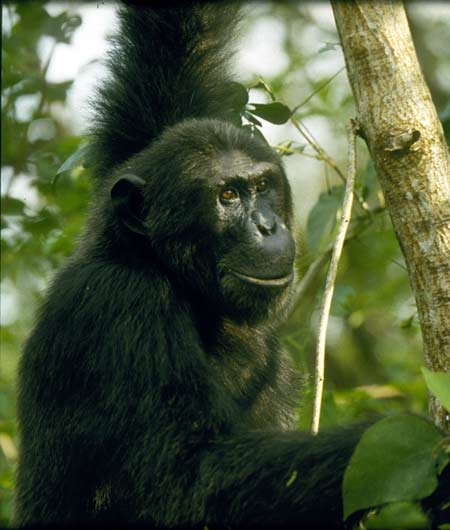Chimp Conservation Plan Drafted


An ambitious plan to save one of mankind’s closest relatives – the chimpanzee – has been hatched by East and Central African nations along with conservation groups.
The 10-year plan would aim to protect chimps from hunting, habitat loss, disease and other threats.
"The conservation of wild populations is important not only for conservation, but also for the survival of chimpanzee cultures in the region that are invaluable to helping us define our own place within the natural realm," said James Deutsch of the Wildlife Conservation Society's Africa Program.
The eastern chimpanzee (Pan troglodytes schweinfurthii), which is known to use tools, is currently classified as "Endangered" on the International Union for Conservation of Nature (IUCN)’s Red List of endangered species and occurs in the Central African Republic, the Democratic Republic of Congo, Sudan, Uganda, Rwanda, Burundi, Tanzania and Zambia.
Threats to the subspecies include: hunting for bushmeat; the capture of infant chimpanzees for the pet trade; the loss and fragmentation of habitat due to agriculture; mining and other forms of human development; and disease.
In one of the most far-reaching efforts to assess the status and conservation threats to eastern chimpanzees, conservation practitioners and researchers with experience from all seven states where the chimps are found contributed data on sightings, nests, feeding signs, and vocalizations from the past decade.
"This effort to assess the status of eastern chimpanzees will help us to focus our conservation actions more effectively," said Andrew Plumptre, director of the Wildlife Conservation Society's Albertine Rift Program and the plan's lead author. "In the next decade, we hope to minimize the threats to these populations and the ecological and cultural diversity they support."
Get the world’s most fascinating discoveries delivered straight to your inbox.
During an August 2009 workshop, more than 30 experts from seven countries traveled to Kampala, Uganda, to identify priorities for the conservation of the subspecies, and to develop an action plan with specific projects for their conservation.
Gaps had to be filled in for some areas off-limits to research because of conflicts.
Participants in the workshop identified 16 chimpanzee units that if successfully protected, would safeguard 96 percent of known chimpanzee populations (estimated to total some 50,000 individual animals).
Eastern chimpanzees are among the best studied of the great apes, due in large part to the work of researchers such as Jane Goodall, who started her fieldwork in Gombe Stream National Park in western Tanzania 50 years ago.
However, the total numbers of eastern chimpanzees across their whole range is poorly known and the models used by the researchers revealed the total population may number as many as 200,000 (almost double the estimates that had been made previously).
"It is clear that we know about the distribution and abundance of only a quarter of the world population of the eastern chimpanzee," said Liz Williamson, the Species Survival Commission Great Ape Coordinator for the IUCN. "There are large areas of the Congo basin where we know very little about this ape."
The plan also targets two of the greatest threats to the species — illegal hunting and trafficking — with a goal of reducing both to half of current levels across most of the animal's range.
Other objectives include: reducing the rate of forest loss in chimpanzee habitats; filling in knowledge gaps in chimpanzee distribution, status and threats; improving the understanding of health risks to chimpanzee populations, including human-transmitted diseases; increasing community support for chimpanzee conservation; and securing sustainable financing for chimpanzee conservation units.
- Top Species Conservation Success Stories
- Gallery: Endangered and Threatened Wildlife
- Video – Jane Goodall's Wild Chimpanzees
This article was provided by OurAmazingPlanet, a sister site to LiveScience.



